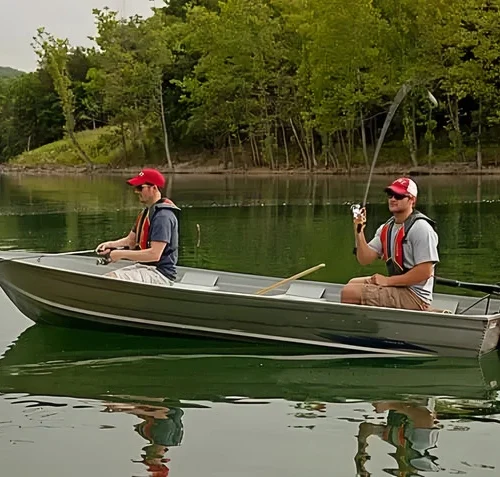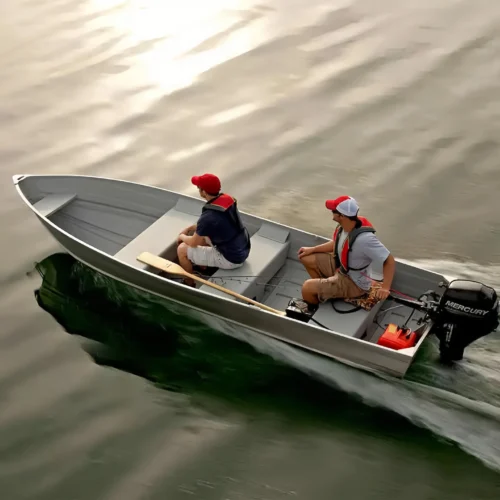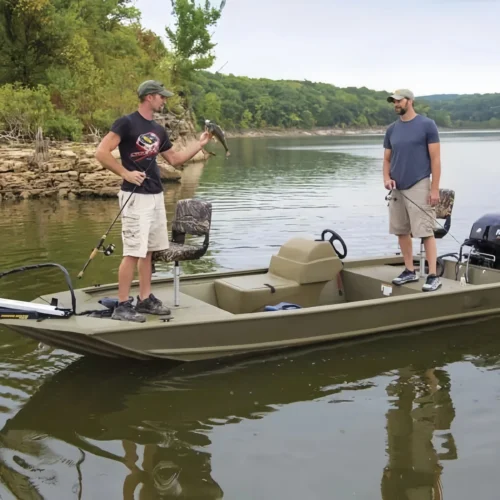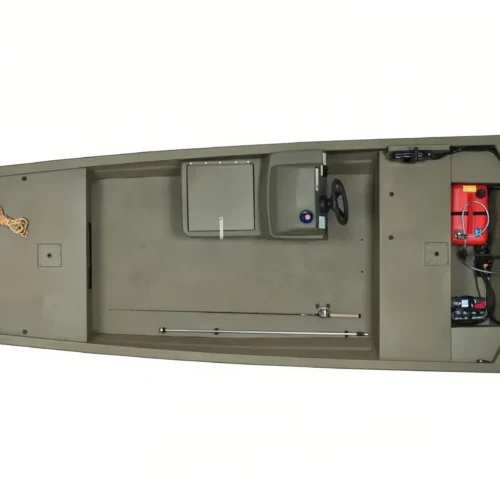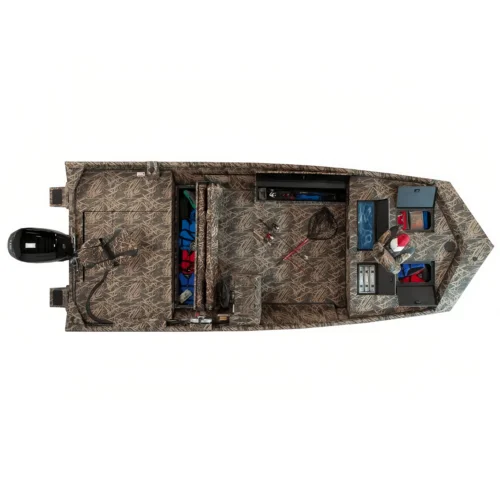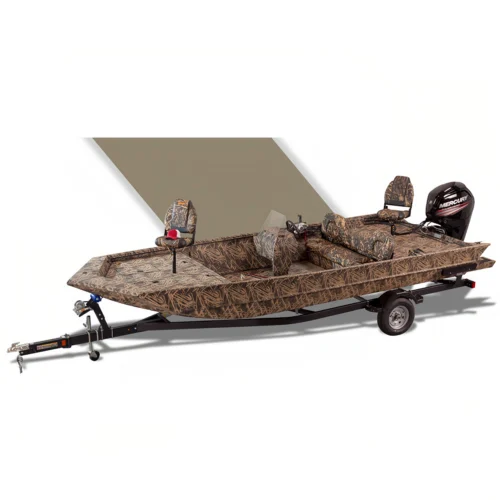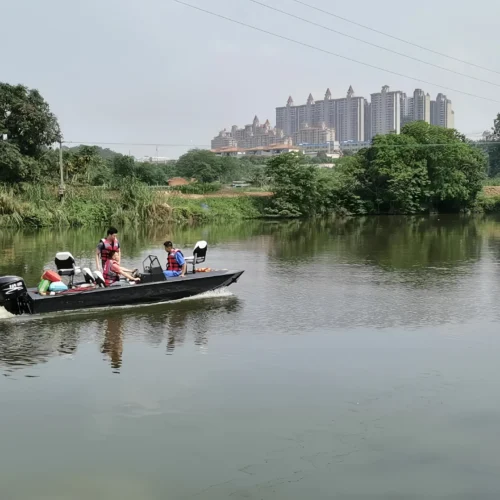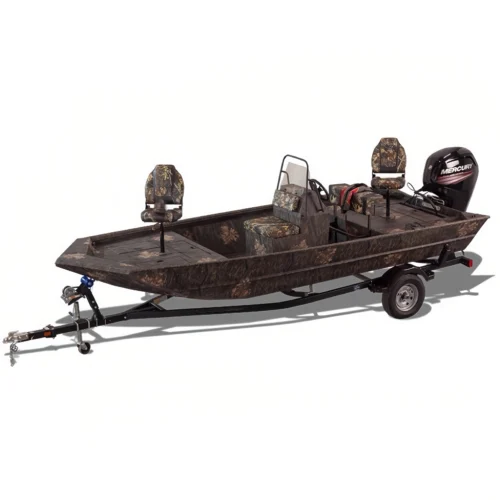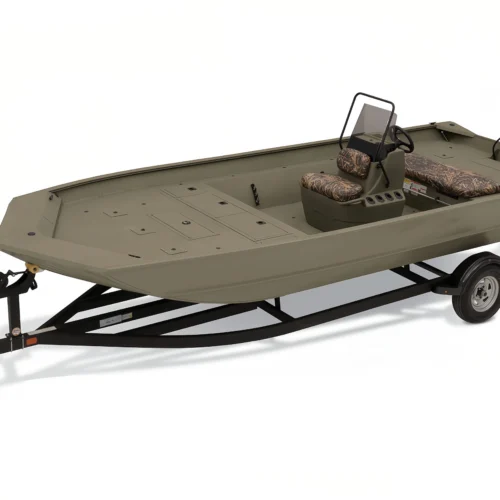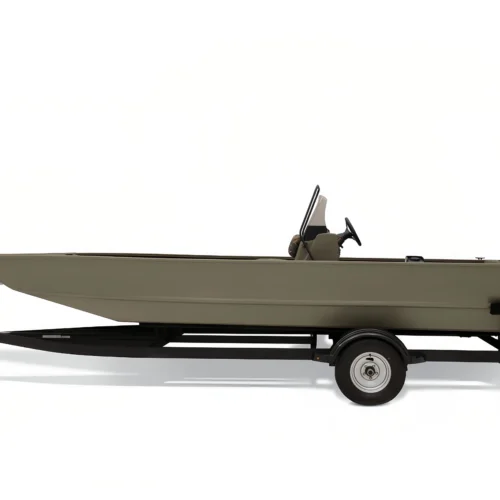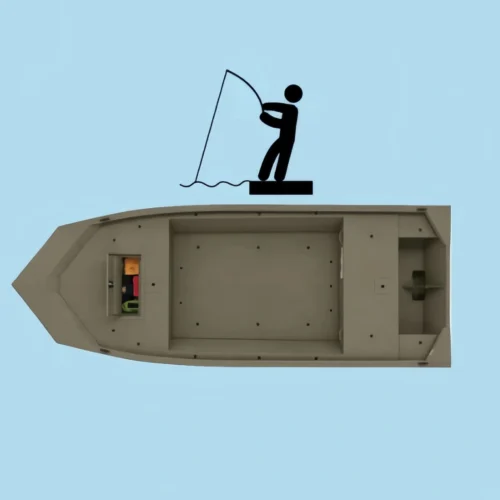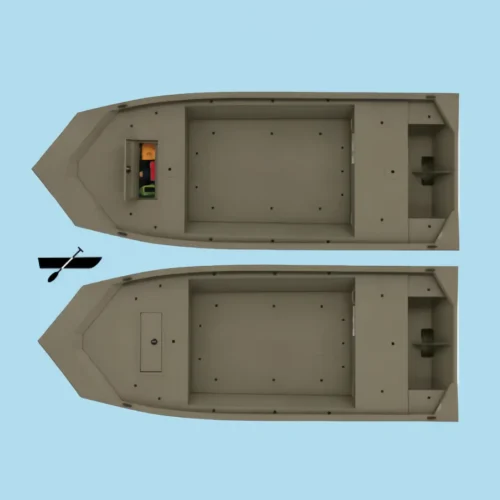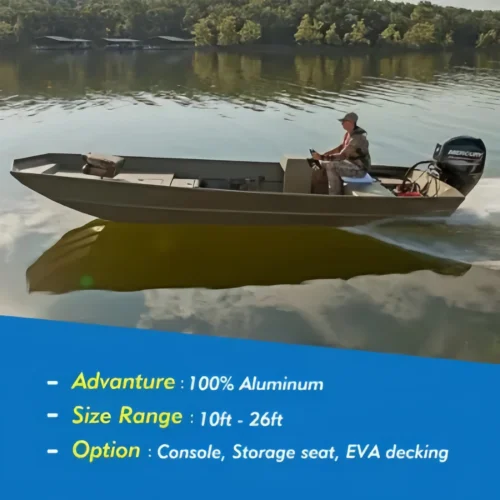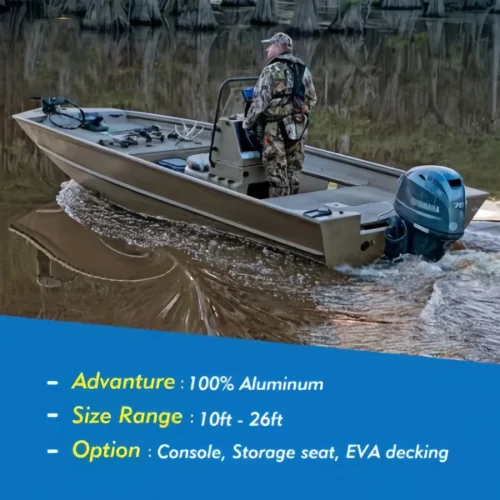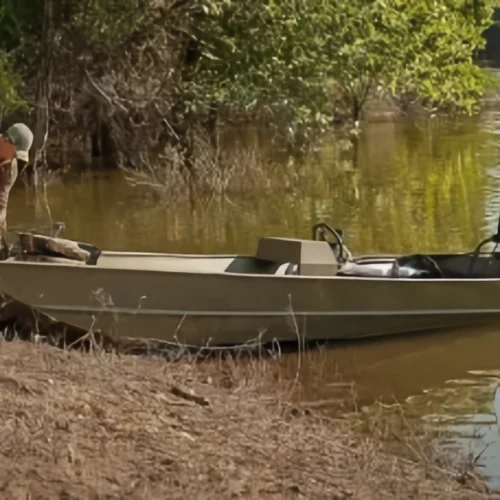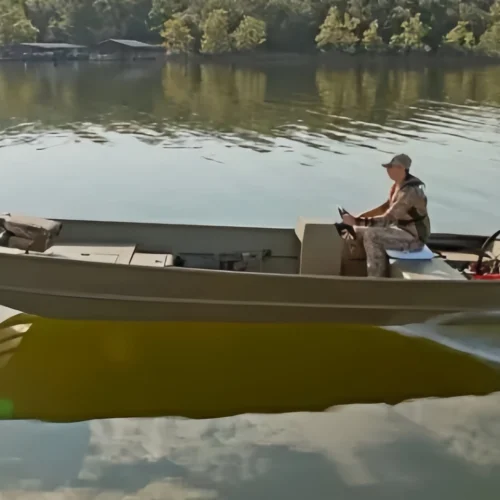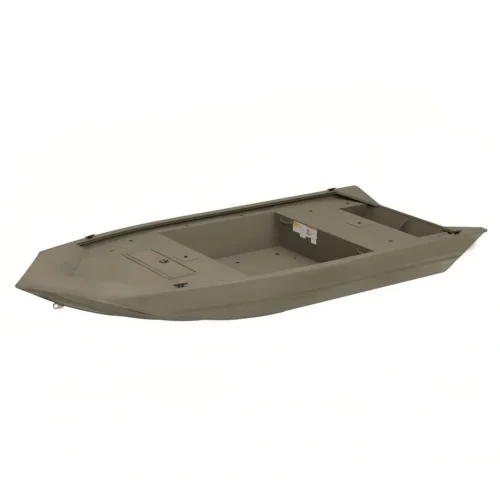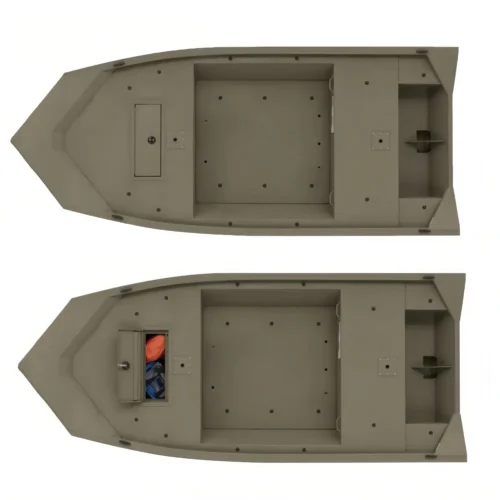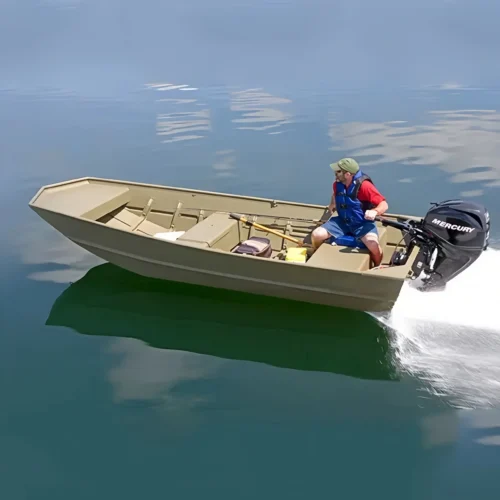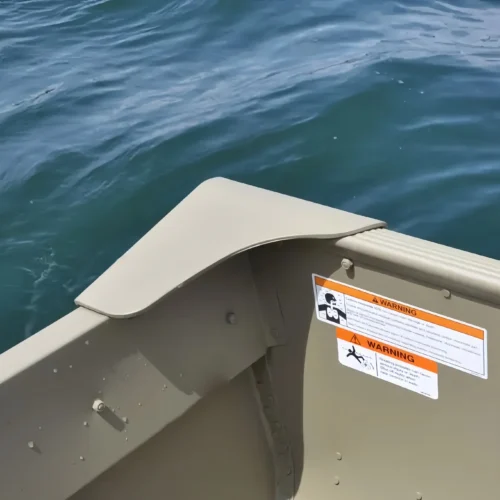Jon Boat FAQs
1. What is a jon boat?
A jon boat is a commonly used recreational freshwater boat. It has gained popularity among fishing and hunting enthusiasts due to its simple construction, affordable price, and lightweight.
With their flat bottom design, jon boats excel in navigating shallow water areas such as lakes, ponds, and swamps. Their good stability and open layout provide more possibilities and convenience for activities like fishing, hunting, or transportation on water.
However, it must be acknowledged that the basic features of jon boats may not offer a high level of comfort to users.
Alumacraft jon boats are typically the most popular and common type of jon boats. Aluminum material is preferred for its lightweight, availability, and durability, which also helps in reducing maintenance costs.
They come in lengths ranging from 8 to 24 feet, with 12-foot and 14-foot jon boats being the most popular sizes. These boats are small enough for easy transport and use while being spacious enough to accommodate 2-3 people for various water activities.
2. How much is a jon boat?
When we search for jon boats, we are often amazed by the wide range of prices they have. The price of jon boats usually varies significantly based on their size, material, and features.
For small-sized alumacraft jon boats without any additional features, prices typically range from $500 to $2,000.
Medium-sized boats with features like jon boat seating, jon boat deck, or small motors would have a more reasonable price range of $2,000 to $8,000.
Larger, fully-equipped jon boats with more durable materials, live wells, larger motors, and consoles can have higher prices, easily surpassing $10,000.
Fortunately, on our NeoBoats platform, the prices for all boats, including jon boats, are more affordable. You can enjoy discounts of up to 40% off the market price. If you're interested, feel free to contact us.
3. How to paint a jon boat?
An experienced angler or hunter often paints their boat to achieve better camouflage. Additionally, painting a boat can also enhance its corrosion resistance and durability.
For budget-conscious boat owners, painting the boat themselves can save some money from the boat budget.
However, painting a boat is not a simple task and usually requires several necessary steps.
Preparation
Firstly, before applying paint, it is essential to thoroughly clean the boat's surface using soap or other cleaning agents.
Once the boat is dry, sanding the surface with 120-220 grit sandpaper is necessary until it becomes smooth enough.
After sanding, the surface should be wiped clean to ensure there is no dust or debris.
Next, it is crucial to cover the areas that do not need to be painted using painter's tape.
Painting
Once the tape is in place, it's time to apply the paint. Typically, a combination of brushes and sprays is used to ensure even coverage.
It is also common to apply a second coat of paint or a clear sealant to provide extra protection and extend the life of the paint.
Important note: painting should always be done in a well-ventilated area, and it is recommended to wear a respirator and safety goggles for the painter's safety.
Waiting for Drying
Finally, it is necessary to choose a well-ventilated area with good lighting but no dust to allow the boat to dry.
After the paint and clear sealant have completely dried, the painter's tape can be removed, and you can enjoy a sturdy and durable jon boat.
Overall, painting a boat requires attention to detail, especially for beginners.
Fortunately, at NeoBoats, most of our jon boats support users in selecting various camouflage colors of paint for free and assist in painting.
4. How much does a jon boat weigh?
If the transportation of traditional, bulky fishing boats bothers you, consider a lightweight and durable jon boat.
In fact, among common recreational boats, jon boats are the lightest and most versatile.
Generally, the weight of a 10-foot jon boat without any equipment can be as light as 80-120 pounds. A 12-foot jon boat typically weighs between 120-140 pounds.
Of course, as the size increases, the weight of the boat will also increase. For example, a 14-foot jon boat can weigh around 150-200 pounds.
Larger jon boats, such as 16-20 feet in length, can weigh between 200-500 pounds or even more.
However, it is evident that compared to other types of boats, the weight of jon boats is remarkably light, making them convenient and easy to transport and use.
5. Are jon boats good for fishing?
Although jon boats may not offer many fancy fishing amenities or provide a high level of comfort, they can be reliable companions for fishing enthusiasts on a limited budget.
Jon boats, constructed primarily of sturdy and affordable aluminum, have low initial costs and require minimal maintenance expenses.
For those with budget constraints, fishing in a jon boat is a cost-effective option.
Thanks to their flat-bottom design, jon boats can navigate smoothly in calm waters and shallow areas while maintaining stability.
Anglers can easily maneuver the boat to explore ponds, streams, and shallow waters where their targets reside. The open space design also provides ample storage for fishing gear, bait, and catch.
6. Are jon boats good for lakes?
Yes, jon boats are designed for calm freshwater environments such as lakes, rivers, and ponds.
The flat-bottom and shallow-draft characteristics of jon boats allow them to navigate relatively smoothly in shallow waters along the edges of lakes.
Their durable aluminum construction means they can withstand a certain level of wear and tear.
Furthermore, their small size and lightweight design make them easy to handle and operate.
Therefore, using a jon boat on calm lakes is feasible. However, it's important to note that they are not designed for comfort and leisure activities. Jon boats typically do not come equipped with plush seating or a bimini top.
The majority of jon boat users utilize them as transportation tools for fishing or hunting, as they excel in accessing shallow areas.
7. Are jon boats safe?
Using jon boats for fishing or hunting on calm water surfaces is generally considered safe.
The flat-bottom design and shallow draft of jon boats allow them to float relatively easily and stably on the water. The open design also supports activities such as fishing, hunting, and leisurely pursuits.
However, there are still subjective and objective safety factors that need to be considered to ensure safety.
Firstly, operators should adhere to boating safety rules when piloting the boat.
Additionally, it is essential to closely monitor weather conditions and avoid traveling in inclement weather.
Most jon boats do not have deep-V hulls, which means they may not handle large waves and severe weather conditions as smoothly.
Before launching, responsible operators should also conduct a thorough inspection of the boat's engine and hull to ensure the integrity of safety components.
Furthermore, ensuring that the number of passengers and cargo onboard the boat remains within its carrying capacity and does not affect the boat's balance is crucial.
Lastly, equipping the boat and passengers with appropriate safety equipment is an important aspect of increasing safety.
Common and lightweight safety devices such as life jackets, first aid kits, and whistles should be provided.
8. Are jon boats stable?
Jon boats can be the favorite small boats for fishermen and hunters not only because of their affordable price but also because of their stability.
Their flat-bottom design allows jon boats to float stably on the water instead of rocking on it. Therefore, they are not easily capsized on calm waters.
Of course, this is based on the assumption that the weight distribution in the boat is even and the water surface is calm.
If you encounter rough waters, it is still important for the boat operator to exercise caution.
9. Can a trolling motor push a jon boat?
Not all jon boats have to rely on outboard motors as their primary power source. Using a quiet and gentle trolling motor as a jon boat motor is also a good choice.
This is especially true for smaller jon boats like 10-foot, 12-foot, and 14-foot jon boats, where an electric jon boat motor would be more economical.
However, for larger-sized jon boats, the weight and horsepower of the boat should be considered when using a trolling motor.
Generally, every 100 pounds of weight requires 2 pounds of thrust, so a trolling motor with 30-50 pounds of thrust can handle a maximum total weight of 1000 pounds.
Additionally, it is important to note that trolling motors rely on a power source. Therefore, for individuals who expect fast driving and long-distance travel, a towing motor may not be suitable.
10. Can a jon boat go in the ocean?
Unfortunately, using a jon boat in the ocean is not a wise decision.
Due to their flat-bottom and shallow draft, jon boats cannot maintain stability in open water with larger waves and wind.
Jon boats are small-sized vessels, typically below 20 feet in length. Such boats are more susceptible to the influence of waves, currents, and wind.
Furthermore, weather changes at sea are unpredictable. In addition, jon boats are generally not equipped with many necessary maritime devices, which makes them essentially unsuitable for saltwater travel.
11. How much hp for jon boat?
Most boats will indicate the range of horsepower they are compatible with, but some jon boats may only provide the hull, requiring the buyer to separately configure the motor and other hardware.
As we know, the larger and heavier boats are better suited for higher horsepower motors, and vice versa.
Based on our boatbuilding experience, jon boat motors ranging from 3 to 6 horsepower are suitable for small boats up to 12 feet in length.
Small boats ranging from 14 to 16 feet typically use motors with 15-20 horsepower. An 18-foot jon boat would use a motor with 25-40 horsepower.
Small boats over 20 feet may use motors with over 50 horsepower.
If you are struggling with choosing a motor for your new boat, you can also contact us. We are happy to help every boating enthusiast resolve their questions.
12. Do you need a boat license for a jon boat?
The licensing requirements for boats in the majority of countries often depend on the type of motor used.
Most regions require a clear boating license and safety course for the use of outboard motors. The regulations for non-motorized boats are not as strict.
However, the specific circumstances vary from country to country and region to region, so it is best to focus on the specific regulations in your area.
That being said, small jon boats have options for power sources, including oars, towing motors, and outboard motors. On the other hand, medium to large-sized jon boats rely on outboard motors for propulsion.
13. Do you need a trailer for a jon boat?
It is believed that some users choose jon boats because of their lightweight and convenient transportation. It must be acknowledged that jon boats, with their small size and lightweight, are impeccable when it comes to storage, transportation, and usage.
Especially for boats within 12 feet, a few people can easily install them onto a truck and transport them.
However, not all jon boats do not require a trailer. For jon boats that are 14 feet and larger, it is more reliable to have a dedicated jon boat trailer for the boat.
While their weight can still be lifted and placed on a roof with some effort, their size may not be suitable for roof transportation. Properly using a trailer will make the transportation and usage process much easier.

